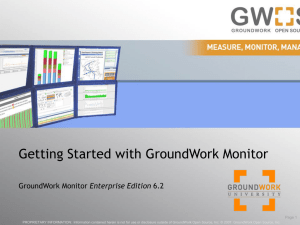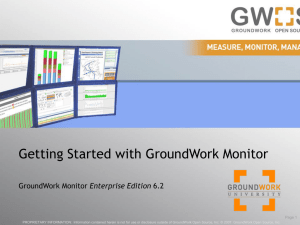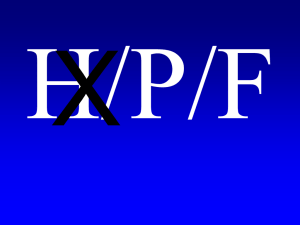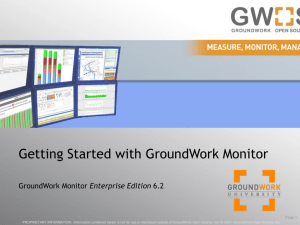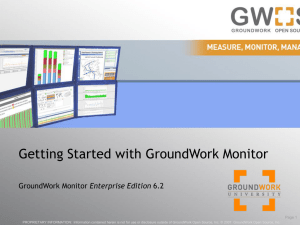Command - GroundWork
advertisement
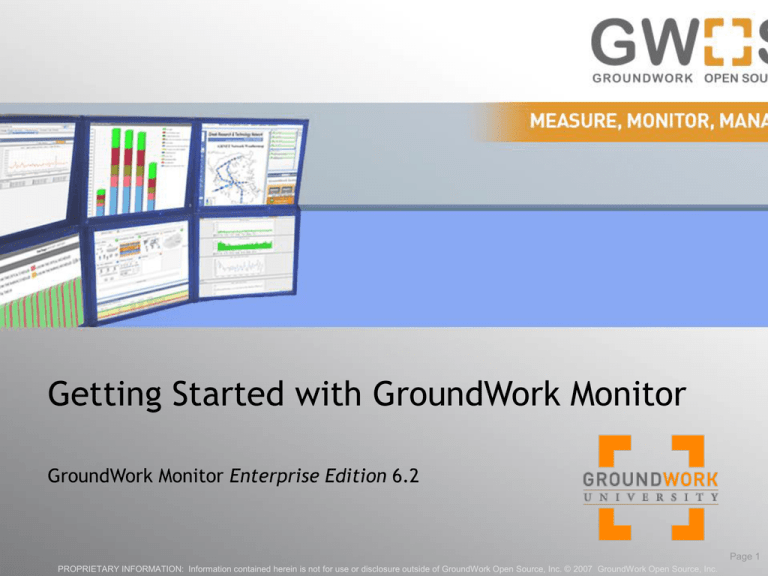
Getting Started with GroundWork Monitor GroundWork Monitor Enterprise Edition 6.2 © 2009 GroundWork Open Source, Inc. PROPRIETARY INFORMATION: Information contained herein is not for use or disclosure outside of GroundWork Open Source, Inc. © 2007 GroundWork Open Source, Inc. Page 1 Getting Started with GroundWork Monitor GroundWork Monitor Enterprise Edition Powerful Monitoring • • • • Fully Supported Product Open Architecture Flexible Configuration Open Source Roots • • • • • • Introductory course How to use the product You must pass the included exams Course takes a day or two Completion is a requirement for Quickstart Support Questions while training? Send them to gettingstarted@gwos.com © 2009 GroundWork Open Source, Inc. Page 2 Getting Started with GroundWork Monitor Course Objectives Nine modules addressing the main features of the product • Introduction to GroundWork Monitor Enterprise Edition • Download and Install • Monarch, the Nagios Configuration Tool • Autodiscovery • Status and Event Console • Dashboards • Notifications and Escalations • LDAP Authentication (optional) • Getting Support © 2009 GroundWork Open Source, Inc. Page 3 Getting Started with GroundWork Monitor Course Objectives for this Module Introduction to GroundWork Monitor Enterprise Edition • Basic Monitoring Process • Applications Overview • Key Monitoring Terminology © 2009 GroundWork Open Source, Inc. Page 4 GroundWork Monitor Enterprise Edition 6.2 Module 1: Introduction to GroundWork Monitor Enterprise Edition © 2009 GroundWork Open Source, Inc. Page 5 Introduction to GroundWork Monitor Enterprise Edition Basic Monitoring Process © 2009 GroundWork Open Source, Inc. Page 6 Process, Concepts, and Approach Basic Monitoring Process CONTROL INPUT Commands and Configurations MONITORING ENGINE DATA INPUT Plugins and Agents DATA OUTPUT Phone, Pager,email Reports, Dashboards CONTROL OUTPUT Event Handlers © 2009 GroundWork Open Source, Inc. Page 7 Process, Concepts, and Approach GroundWork Monitor Software Architecture Presentation Authentication User Interface Portal Configuration Portal Administration Status Status & Event Viewer Viewers Configuration Dashboard Widget Custom Report Dashboards Advanced Reports Datacenter Integration (CMDB, Notifications, OLAP, Incident Management Mobility Interfaces Jboss Portal Collection Command Web Service Status Web Service Performance Web Service Reporting ODI Configuration API Event Web Service Data Management Foundation Normalization MySQL Datastore Persistence/Caching Feeders Instrumentation Nagios Data Collection Plugin API Event Broker API Cacti Data Input Scripts NeDi NTop NetSNMP SNMPTT MIBS snmptt Rules WebInject Ganglia SEC Tests Metric Modules Rules New Data Collector or Subordinate Monitoring System Environment KEY © 2009 GroundWork Open Source, Inc. Documented in GDK WIKI Documented in Bookshelf Extensible Page 8 Introduction to GroundWork Monitor Enterprise Edition Enterprise Edition Applications Overview © 2009 GroundWork Open Source, Inc. Page 9 Enterprise Edition Applications Overview GroundWork Monitor Enterprise Edition Applications Administration – Portal administration. Manage users, roles, and integrate new applications. Auto Discovery – Discover equipment on your network and deploy appropriate monitors. Configuration – Graphical Nagios configuration. Includes Performance Configuration tool. Reports – GroundWork Reports (Service Level), Insight Reports (System Availability and Performance), and integrated Nagios Reports (Outage, Alerts and Notifications)Performance View – Configure RRD based Performance Graphs from monitoring data Status – AJAX enabled web-based interface to view monitoring data. Includes Performance Graphs. Event Console – Real time operations nerve center view. My GroundWork – Personally configurable private dashboard for each user Dashboards– Shared customizable dashboards for all users. Create unique views of the infrastructure Resources – GroundWork Monitor product documentation and Open Source reference. WebMetrics – Versatile web site monitoring using the WebMetrics service Advanced– Nagios in its original CGI form © 2009 GroundWork Open Source, Inc. Page 10 Introduction to GroundWork Monitor Enterprise Edition Key Definitions © 2009 GroundWork Open Source, Inc. Page 11 Key Definitions Monitoring Terminology Hosts – A server, workstation, or device for which the availability status is to be tracked or mapped (e.g. localhost). Services – A monitor or check of a particular parameter/status associated with a Host (e.g. Current Load). Host Groups – An arbitrary collection of Hosts into named sets (e.g. Linux Servers) State – The condition of Services and Hosts (e.g. UP, DOWN and OK, CRITICAL or WARNING for services). State Change – Soft - the system retries a service check a programmable number of times; and Hard - the retries have been exceeded. © 2009 GroundWork Open Source, Inc. Page 12 Key Definitions Monitoring Terminology Contacts, and Contact Groups – Contacts identify who should receive alert/recovery notifications in the event of a problem on your network; Contact Groups are groupings of one or more contacts. Notifications and Escalations –Communications to Contacts or Contact Groups for any hard state change, hosts or service remaining in non-OK state, and acknowledgements. Flapping – Frequent changes in state, resulting in a storm of alarm and recovery notifications. GroundWork Monitor can be configured to suppress alarms during flapping. Downtime – Scheduling downtime avoids alarm fatigue, provides more accurate reports, generates a maintenance log.. Dependencies – When a monitored item is not on the same subnet as the monitoring server, monitoring is dependent upon the intervening switches and routers. © 2009 GroundWork Open Source, Inc. Page 13 Key Definitions Monitoring Terminology States of Hosts • Nagios assigns a State to each Host and Service • Hosts either respond to a Host Check (typically a ping) or they don’t • Based on this, the primary States for a host are UP or DOWN • In addition, if a Host is behind a known network outage it will be given State of UNREACHABLE Host States UP DOWN UNREACHABLE © 2009 GroundWork Open Source, Inc. Page 14 Key Definitions Monitoring Terminology States of Services Services are compared against acceptability thresholds and have three states (OK, WARNING & CRITICAL) • • If a measured parameter in a service is less than the WARNING threshold it returns a State of OK • If that parameter exceeds the WARNING threshold but is less than the CRITICAL threshold it returns WARNING • If that parameter exceeds the CRITICAL threshold it returns a State of CRITICAL • Thresholds can be more complex than this example and contain multiple parameters • If the service is configured incorrectly (i.e. bad arguments) return can be UNKNOWN OK Service States Plugin Errors WARNING UNKNOWN © 2009 GroundWork Open Source, Inc. CRITICAL Page 15 Key Definitions Monitoring Terminology Dependencies When a monitored item is not on the same subnet as the monitoring server, monitoring is dependent upon the intervening switches and routers. Dependency Relationships N R1 R2 SW1 SW2 S1 S4 M4 M5 S2 S3 M3 M1 © 2009 GroundWork Open Source, Inc. M2 Page 16 Key Definitions Monitoring Terminology There are five kinds of dependency relationships Network dependencies exist between devices and their upstream parents (defined using the parents directive) • • Example: A host can depend on an upstream switch • One host can depend on another host somewhere in the network (defined using the host_dependency directive) • Example: A web server can depend on a load balancer • A service on one host can depend on a service on another host (service_dependency directive) • Example: An Application server’s speed can depend on a Database server’s query response time • Services can depend on other services on the same server (defined using the service_dependency directive) • Example: An snmp check can depend on the snmpd running on the same server • Services have an inherent dependency on the server upon which they run © 2009 GroundWork Open Source, Inc. Page 17 Key Definitions Monitoring Terminology Plugins, Commands, Services, and Profiles (1 of 2) – Nagios - is the scheduler used in the GroundWork Monitor package – Nagios executes external Plugins – The command line syntaxes for Plugins are stored in Command definitions – Scheduling, notification and procedural information for the Commands are stored in Services – Breaking from Nagios rules, GroundWork separates the definition of Services from Hosts to permit selection from a library of Services – A set of Services, appropriate for monitoring a particular architecture, can be stored in a Service Profile – Host Profiles are a collection of a Host Template plus one or more Service Profiles © 2009 GroundWork Open Source, Inc. … in other words Page 18 Key Definitions Monitoring Definitions (continued) Plugins, Commands, Services, and Profiles (2 of 2) – – – – – Host Profiles incorporate Service Profiles Service Profiles incorporate Services Each Service incorporates one Command Each Command invokes one Plugin The Plugin stands alone Host Profile Host Template Service Profile web_monitoring Service Profile Service cpu Service Service memory Service Service disk Service Command check_cpu Command Command check_mem Command Command check_disk Command Plugin Plugin Plugin Plugin Plugin Plugin © 2009 GroundWork Open Source, Inc. Service httpd Service Command check_process Command Plugin Plugin Service url_get Service Command check_http Command Plugin Plugin Page 19 Thank you GroundWork Open Source, Inc. 139 Townsend Street, Suite 500 San Francisco, CA 94107 Phone: 415.992.4500 Website: www.gwos.com Email: info@gwos.com GroundWork Subscription Support: support.gwos.com © 2009 GroundWork Open Source, Inc. Confidential - Do not distribute Page 20
